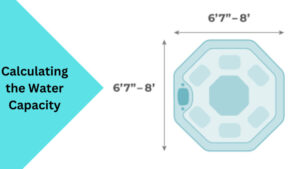Have you ever wondered How Much Water Does A Hot Tub Hold? Whether you’re a new hot tub owner or simply curious about these luxurious water sanctuaries, understanding their water capacity is essential.
In this comprehensive guide, we will explore the factors that influence the amount of water a hot tub can hold and provide tips for calculating and converting those measurements. Additionally, for those considering an indoor hot tub installation, we’ll address common problems and offer valuable solutions. So, let’s dive in and discover the secrets behind hot tubs and their water capacity!
Understanding Hot Tubs and Their Water Capacity
Before we delve into the specifics of hot tub water capacity, let’s familiarize ourselves with these delightful tubs of tranquility. Hot tubs, also known as spas, are self-contained units designed for relaxation, hydrotherapy, and socializing. These recreational vessels typically feature heated water and powerful jets that provide a soothing massage experience.
Hot tubs vary in size, shape, and seating capacity, offering a range of options to suit individual preferences and space limitations. Now, let’s explore the factors that can affect the water capacity of a hot tub. Here is a complete guide about How To Properly Water Your Gunite Pool:
Factors Affecting Hot Tub Water Capacity
Size and Shape of the Hot Tub
The size and shape of a hot tub directly influence its water-holding capacity. Larger hot tubs naturally have a greater volume, allowing for more water. Similarly, hot tubs with unique shapes, such as circular or triangular designs, may have different water capacities due to variations in internal dimensions.
Depth of the Hot Tub
The depth of a hot tub has a direct impact on its water capacity. Deeper hot tubs require more water to fill them, while shallower models hold less water. When considering the perfect hot tub for your needs, make sure to take into account both the depth and capacity that aligns with your preferences and available space. To explore more details and considerations regarding Depth of A Gunite Pool, our comprehensive guide on Can You Change the Depth of a Gunite Pool has you covered.
Number of Seats and Loungers
The number of seats and loungers in a hot tub also affects the amount of water it can hold. Each seat and lounger adds to the overall capacity, as water fills the space beneath them. If you anticipate frequent gatherings with friends and family, opting for a hot tub with ample seating can ensure everyone has enough room to relax and enjoy the therapeutic benefits.
Additional Features and Accessories
Many hot tubs come equipped with additional features and accessories, such as built-in waterfalls, LED lighting, or integrated sound systems. While these enhancements contribute to the overall ambiance of your hot tub experience, they may require additional space, potentially affecting the water-holding capacity. Take note of these extras and consider their impact when determining the appropriate water capacity for your hot tub.
Now that we understand the factors influencing hot tub water capacity, let’s explore how to calculate it effectively.
Calculating the Water Capacity of a Hot Tub

Calculating the water capacity of your hot tub is a vital step to ensure its optimal performance and enjoyment. Follow these simple steps to determine the amount of water your hot tub can hold:
- Measure the length, width, and depth of the tub’s interior in feet.
- Multiply these dimensions together to calculate the volume in cubic feet.
- Convert the volume to gallons by multiplying the cubic feet measurement by 7.48, as there are approximately 7.48 gallons in one cubic foot.
- Round the calculated number to the nearest whole number to obtain the water capacity of your hot tub in gallons.
By accurately calculating the water capacity, you can take full advantage of your hot tub’s relaxing properties without any surprises or disappointments.
Converting Hot Tub Water Capacity to Liters
While gallons are a commonly used unit of measurement for hot tub water, some individuals prefer the metric system. If you find yourself among them, converting your hot tub’s water capacity to liters is a simple process.
To convert your hot tub’s water capacity from gallons to liters, multiply the calculated number of gallons by 3.785, as there are approximately 3.785 liters in one gallon. Round the result to the nearest whole number, and voilà! You now know the water capacity of your hot tub in liters.
Hot Tubs Indoors: Tips to Overcome Problems
Installation of a hot tub indoors brings a host of advantages, including year-round use and increased privacy. However, it can also come with a unique set of challenges. Let’s address some common problems associated with indoor hot tub installations and provide valuable solutions.
Problem 1: Humidity Control
Indoor hot tubs produce steam and heat, which can lead to excess humidity in the surrounding space. High humidity levels may cause issues such as condensation, mold growth, and unpleasant odors. To combat these problems, consider implementing the following measures:
- Install a dehumidifier in the room to regulate humidity levels effectively.
- Ensure proper ventilation by using fans or opening windows when using the hot tub.
- Opt for a hot tub equipped with an integrated ventilation system to minimize moisture buildup.
Problem 2: Structural Support
Hot tubs are heavy, and when installed indoors, it is essential to ensure that the floor can bear the weight. Neglecting structural support may lead to sagging floors or even collapse. Here’s how to address this concern:
- Consult a structural engineer or a professional contractor to assess the load-bearing capacity of your chosen location.
- Reinforce the floor if necessary, using additional support beams, brackets, or even upgrading the flooring material.
Problem 3: Water Damage
Indoor hot tubs pose a greater risk of water damage compared to outdoor installations due to their proximity to sensitive areas of your home. To safeguard against potential water damage, consider these preventative measures:
- Install waterproof flooring materials, such as ceramic tiles or vinyl, in the immediate vicinity of the hot tub.
- Place water-resistant barriers or mats beneath and around the hot tub to capture any potential spills or leaks.
- Regularly inspect the hot tub’s plumbing and connections for signs of wear, and promptly address any issues to prevent water damage.
By addressing these common problems and implementing proactive solutions, you can enjoy your indoor hot tub with peace of mind.
Conclusion
Hot tubs offer a blissful retreat from the stresses of daily life, and understanding their water capacity is essential for a satisfying experience. By considering factors such as size, shape, depth, and additional features, you can select a hot tub tailored to your preferences.
Additionally, knowing how to calculate and convert water capacity measurements empowers you to make informed decisions. For those considering an indoor hot tub installation, addressing issues such as humidity control, structural support, and water damage can ensure a seamless integration into your home.
So go ahead, dive into the world of hot tubs and enjoy the relaxation, rejuvenation, and tranquility they bring!

Greetings, fellow pool enthusiasts! I’m Turner Davis, your dedicated guide to the world of pool care and maintenance. With over a decade of experience in the field, I’ve made it my mission to transform ordinary pools into extraordinary aquatic retreats.

